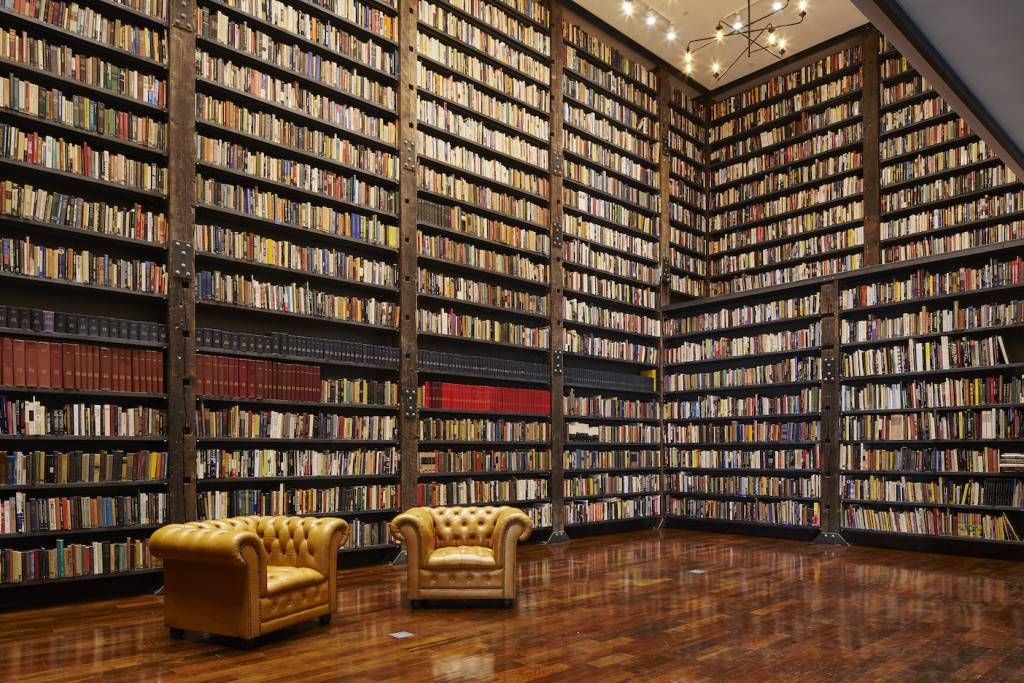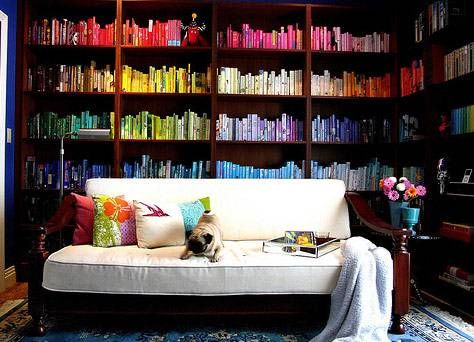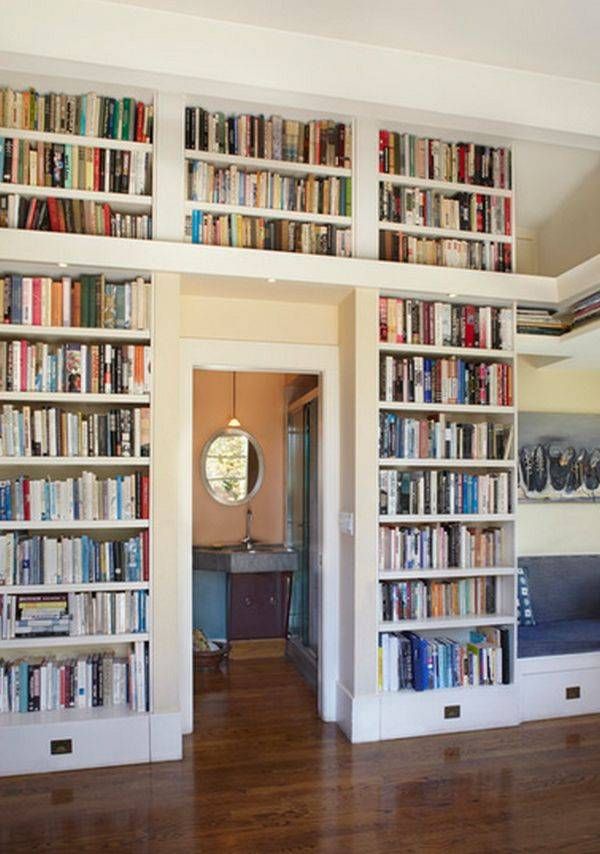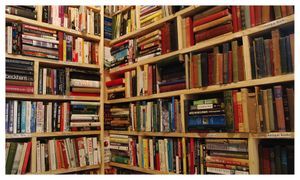I’ll cover the pros and cons of organizing:
Alphabetically By genre By color Chronologically Autobiographically And loads more (including tips for extreme book hoarders)
The pros and cons of alphabetizing
Alphabetizing is one of the most obvious options, and is likely the best way if you want to quickly find a particular book. You can go the library-esque route and alphabetize the last name of the author, or you can be a rebel (bad boy/girl, you!) and alphabetize by title. As with any organizational method, there are pros and cons to this choice.
Pros:
It’s easy, assuming you know the alphabet. Friends, family, or strangers who want to find something in your bookshelves will know how to do it.
Cons:
It’s not unique or interesting. It can take a while to add new books. This is actually a con for most of the options I’ve found to organize bookshelves with a lot of books—you can spend hours getting them just how you want them, but as soon as you have a new handful to add, you have to shift and move a ton more books.
The pros and cons of organizing by genre
If you’re an equal opportunity reader and have books that cover a wealth of genres, then you may want to arrange them as such. You can arrange your books by whatever genres you have, such as:
Fiction Mystery Art and design Young Adult Reference Graphic novels Hobby
If you’re an uber-nerd (Hi! I like you!) then you may even break it down into subgenres.
Pros:
It makes it easy to find a book if you’re in a particular mood for one genre over another. For people who are very familiar with what’s on their shelf, this option can be more intuitive than alphabetizing.
Cons:
It can be tricky to decide what genre books fall into. For example, if you had genre sections for mystery and detective, there would be a lot of overlap. It can be harder for others to make sense of your organization. You’ll have to decide how to organize them within the genre. You may break it down by genre and then alphabetize within that genre, color code them, or…there are a lot of options that can make this more complicated.
The pros and cons of organizing by color
If you’ve been on the internet in the last decade then you’ve likely seen plenty of photos of people organizing their bookshelves by color. There are a lot of interesting options within the color-organizing category, such as arranging them into some type of pattern within the color coding, or actually covering your books with wrapping paper so that different sections are clear.
Pros:
It looks cool. When you post pictures of it on the internet, many people on the internet will think you’re cool.
Cons:
It isn’t very practical for most people. Unless you only know your books by the color of their cover, it can make it hard to find what you need. It can be aggravating trying to figure out where to place each book. Is this blue cover darker or lighter than this blue cover? Definitely darker. Wait, but this one is lighter…or is it? When you post pictures of it on the internet, many people will be legitimately angry in your general direction. I don’t know why this is but some people feel VERY STRONGLY about color-coded books.
The pros and cons of chronological organizing
While this can be harder for fiction titles, it’s not uncommon for folks who have mostly non-fiction titles to organize them chronologically. Generally this isn’t done by the date the book was published but rather by the dates the subject matter covers. For example, history books might be organized starting with Ancient Greece up through 18th Century British History, and then into current history books.
Pros:
You can easily find a series of books on the same subject. Nerds love this type of organization. It’s satisfying.
Cons:
Many books cover more than one topic. Would you shelf a book about World War II before or after a book about the presidency of FDR? This takes a lot of time. If you’re looking for ideas on how to organize bookshelves with a lot of books, you may be looking at a multi-week project to get this one done. It can be hard to continue shifting and shelving new books as they come in.
The pros and cons of autobiographic organizing
Books are more than just paper, ink, and glue. They’re personal objects that we love to surround ourselves with. If looking at your tattered copy of Pride and Prejudice brings back memories of your freshman dorm room, or if you laugh to remember your mansplaining uncle buying The Fountainhead for you, then you may want to consider organizing your books autobiographically. This is a highly personal method that requires some serious soul searching. It’s unlikely you’ve ever read a book in a vacuum and it’s likely that the same tome can bring up memories of very different times in your life. That said, if you want to maximize the nostalgic feelings you get when organizing your books, then designing your own autobiographical method can be hugely satisfying.
Pros:
There isn’t a more personal way to organize your books. You’ll likely love the feelings you get as a result, when you go through your books shelf by shelf and remember what they represent to you.
Cons:
This is hugely complicated and will take a long time to complete. It would not only be impossible for others to find books on your shelves, but it will likely be hard for you. This may be fine for someone with a few dozen books, but for those looking for answers on how to organize bookshelves with a lot of books, this isn’t a good option.
Combo is the way to go
I like a lot of these options but no single one worked for my needs. That’s why I’ve used a combination. I have five bookcases in my home, which are organized thusly:
How to organize bookshelves with a lot of books: The hoarder’s edition
The above tips are for folks who have many, many books and aren’t sure how to organize them in a thoughtful, satisfying way. But what of those of us who don’t want to necessarily make things pretty, but just want to make things fit? What of those of us with five (or more) bookcases that are overflowing and are starting to look like a safety/fire hazard?
There are some ways you can maximize the space on your shelves, too:
Go horizontal. Vertical shelving is what we’re all used to but it’s not the most practical when you’re trying to make use of every inch of shelf space. Stack them horizontally, or shelve most vertically and then stick some horizontally on top of their new vertical buddies. Use your shelves for support. If you’ve run out of space on the bookshelves themselves, stack books next to them, using the bookcases as support. Just remember not to stack them too high or you’ll have a heck of a time getting to the books on the bottom. Use books usefully. The computer monitor I’m starting at right now is perched on three books that are simply too large and tall to justify taking up space on my shelves: The Complete Tales & Poems of Edgar Allen Poe, The Ground Beneath Her Feet by Salman Rushdie, and Random House Webster College Dictionary. Surely you don’t want to put your books in harm’s way, but perhaps you can find similar ways to use your books. Need a bedside table? Stack a bunch of books! Need a new cutting board? Go buy one—books wouldn’t make a good cutting board, now you’re just being silly. Stack books in unused spaces—under beds, in empty drawers, under coffee tables. Hang shelves from any space that’s not being used. That space above your fridge? Why waste it—hoard books there!
There you have it—the simple, complex, and hoarder’s answers to how to organize bookshelves with a lot of books. What’d I miss? How do you keep all your favorites organized and easily accessible?



